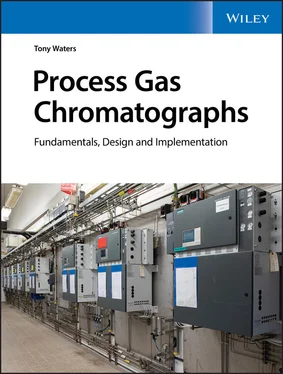1 Cover
2 Preface References
3 Contributors
4 Acknowledgments
5 Part One: PGC fundamentals 1 An introduction Chromatographic separation The gas chromatograph The oven The sample injection valve The column The detector Did you get it?Self‐assessment quiz: SAQ 01 Student evaluation test: SET 01 References Figures New technical terms 2 Peak shape How columns work How peaks form Some conclusions Did you get it?Self‐assessment quiz: SAQ 02 Student evaluation test: SET 02 References Figures Equation Symbols New technical terms 3 Separation How peaks get separated Measurements from chromatograms Did you get it?Self‐assessment quiz: SAQ 03 Student evaluation test: SET 03 References Figures Equations Symbols New technical terms 4 Peak patterns Predictable patterns in peak position Predictable patterns in peak width Predictable patterns in retention Did you get it?Self‐assessment quiz: SAQ 04 Student evaluation test: SET 04 References Figures Equations Symbols New technical terms
6 Part Two: PGC analytics 5 Industrial gas chromatographs Process analyzers Process gas chromatographs Competing technologies The PGC analytics unit Did you get it?Self‐assessment quiz: SAQ 05 Student evaluation test: SET 05 References Figures Table Symbol New technical terms 6 Carrier gas systemChoice of carrier gas Carrier gas purity Carrier gas supply system Pressure regulation Flow regulation Did you get it?Self‐assessment quiz: SAQ 06 Student evaluation test: SET 06 References Table Figures Symbols New technical terms 7 Sample injection Introduction Injecting gas samples Injecting liquid samples Other techniques Did you get it?Self‐assessment quiz: SAQ 07 Student evaluation test: SET 07 References Tables Figures Symbols New technical terms 8 Chromatographic valves Valve technology The strange effect of competition Valve types Valve leaks Valve leak mitigation Did you get it?Self‐assessment quiz: SAQ 08 Student evaluation test: SET 08 References Table Figures New technical terms 9 Column systems Two fundamental issues The temperature ramp solution The multiple column solution The choice Delayed injection Four types of column system Type A: A single column Type B: Multiple columns, single detector Type C: Multiple detectors, single injector Type D: Multiple sample injectors Elemental column systems Backflush column system Distribution column system Heartcut column system The real power Endnote Did you get it?Self‐assessment quiz: SAQ 09 Student evaluation test: SET 09 References Table Figures New technical terms 10 Detectors Introduction Types of detector Thermal conductivity detector Flame ionization detector Flame photometric detector Other detectors Did you get it?Self‐assessment quiz: SAQ 10 Student evaluation test: SET 10 References Tables Figures Equations Symbols New technical terms 11 Temperature control Need for stability The air‐bath oven The airless oven Direct column heating PGC standardization A closing thought Did you get it?Self‐assessment quiz: SAQ 11 Student evaluation test: SET 11 References Table Figures New technical terms
7 Part Three: PGC control 12 Event scheduling A sequence of actions Timing mechanisms Control of analyzer operation Peak identification Did you get it?Self‐assessment quiz: SAQ 12 Student evaluation test: SET 12 References Figures New technical terms 13 Data display techniques The chromatogram display The bargraph display The trend record Digital signal processing PGC function alarms Did you get it?Self‐assessment quiz: SAQ13 Student evaluation questions: SET‐13 References Table Figures New technical terms 14 Peak area integration Digital chromatogram processing Quantifying the analyte peaks Measuring overlapping peaks Did you get it?Self‐assessment quiz: SAQ 14 Student evaluation test: SET 14 References Figures New technical terms 15 Calibration Measurement principles Calibration methods Did you get it?Self‐assessment quiz: SAQ 15 Student evaluation test: SET 15 References Figure Equations Symbols New technical terms
8 Answers to self‐assessment questionsSAQ‐01 SAQ‐02 SAQ‐03 SAQ‐04 SAQ‐05 SAQ‐06 SAQ 07 SAQ 08 SAQ 09 SAQ 10 SAQ 11 SAQ 12 SAQ 13 SAQ 14 SAQ 15
9 BibliographyBibliography
10 Glossary
11 Index
12 End User License Agreement
1 Chapter 5Table 5.1 Comparing the Process Photometer and the PGC.
2 Chapter 6Table 6.1 Properties of Common Carrier Gases.
3 Chapter 7Table 7.1 Sample Loop Tubing Sizes.Table 7.2 Temperature, Pressure, and Liquid Density.Table 7.3 Conversion of Percentage Units for Gas Samples.
4 Chapter 8Table 8.1 Summary of PGC Chromatographic Valves.
5 Chapter 9Table 9.1 Summary of Column Systems.
6 Chapter 10Table 10.1 Key Features of the Thermal Conductivity Detector.Table 10.2 Key Features of the Flame Ionization Detector.Table 10.3 Key Features of the Flame Photometric Detector.Table 10.4 Summary of PGC Detectors.
7 Chapter 11Table 11.1 Summary of Oven Heating Methods.
8 Chapter 13Table 13.1 The First Microprocessor‐Based PGC Control Units.
1 Chapter 1 Figure 1.2 Basic Gas Chromatograph. Figure 1.3 Typical Gas Sample Injector Valve. Figure 1.4 Typical Gas Chromatographic Columns. Figure 1.5 A Simple Column Switching System. Figure 1.6 Three Kinds of Capillary Column. Figure 1.7 Typical Chromatograms. Figure 1.8 A Real Chromatogram.
2 Chapter 2 Figure 2.1 Gases Dissolve in Liquids. Figure 2.2 A Different Gas. Figure 2.3 Forming an Equilibrium. Figure 2.4 The Carrier Gas Moves. Figure 2.5 The Second Equilibrium. Figure 2.6 The Third Equilibrium. Figure 2.7 The Fourth Equilibrium. Figure 2.8 The Fifth Equilibrium. Figure 2.9 Effect of Having More Equilibria.
3 Chapter 3 Figure 3.1 Effect of Component Solubility. Figure 3.2 Draw Your Own Chromatogram. Figure 3.3 Significance of an Air Peak. Figure 3.4 Typical Chromatogram Measurements.
4 Chapter 4 Figure 4.1 The Doubling Rule. Figure 4.2 Diagnosing Peak Identities. Figure 4.3 Effect of Temperature Ramp. Figure 4.4 Fast Analysis of Natural Gas. Figure 4.5 Measurements for Separation Factor. Figure 4.6 Measurements for Resolution. Figure 4.7 Same Separation, Different Width. Figure 4.8 Patterns in Resolution.
5 Chapter 5Figure 5.2 A Very Old PGC with an Even Older PGC Engineer.Figure 5.3 Process Gas Chromatograph Functions.Figure 5.4 A Typical PGC Column Oven.
6 Chapter 6Figure 6.1 Effect of Impure Carrier Gas.Figure 6.2 A Vacancy Peak in a Real Chromatogram.Figure 6.3 Automatic Changeover Regulator.
7 Chapter 7Figure 7.1 Typical PGC Sample Injector Valve. Source: ABB Process Analytics ...Figure 7.2 Gas Sample Injection.Figure 7.3 Atmospheric Referencing Systems.Figure 7.4 Liquid Sample Injection.Figure 7.5 Plunger Valve for Liquid Sample Injection. Source: ABB Process An ...
8 Chapter 8Figure 8.1 Function of a Spool Valve.Figure 8.2 Early Six‐Port Slide Valve.Figure 8.3 Slide Valve for Liquid‐Sample Injection.Figure 8.4 Slide Valve for Gas‐Sample Injection.Figure 8.5 Rotary Gas‐Sample Injector Valve.Figure 8.6 Example of a Valve Rotor and Stator.Figure 8.7 Six‐Port Rotary Liquid‐Sample Injector.Figure 8.8 Miniature Multiport Rotary Valve.Figure 8.9 Pressure‐Seal Diaphragm Valve.Figure 8.10 Piston/Plunger‐Seal Diaphragm Valve.Figure 8.11 Diaphragm Valve‐Switching Mechanism.Figure 8.12 Plunger Valve for Liquid Sample Injection.Figure 8.13 Typical Plunger Valve Operation.Figure 8.14 Purging Grooves to Intercept Leakage.
9 Chapter 9Figure 9.1 Type A Column System.Figure 9.2 Type B Column System.Figure 9.3 Type C Column System.Figure 9.4 Type D Column System.Figure 9.5 Ten‐Port Gas Injector and Backflush System.Figure 9.6 Distribution Column System.Figure 9.7 Heartcut Column System.Figure 9.8 A Real Heartcut Chromatogram. Source : Author's collection.Figure 9.9 Trap‐and‐Hold Column System.
Читать дальше












